- Home
- Deceptions
- Solar
- Thermal Audit
- Ventilation
- Sensors
- Governance
- Environment
- Reference
- Contact
- News
Mold - when basement vapor barriers are bad
Vapor barriers can be misguided when used as dictated by building codes in cement basement walls.
Building vapor barriers are generally considered beneficial, necessary and required for building code compliance, so I realize that taking a poke at the status quo will lead to some hostility. The conventional wisdom goes along these lines:
1) Moist air is generated by building occupants and human activities like cooking and showering.
2) If the moisture passes through the drywall and fiberglass insulation and contacts the cold exterior walls (in winter), it will condense and promote the growth of mold. This must be prevented.
While true for the above ground exterior walls, basement walls are a different matter. Cement is extremely porous and allows moisture to enter the basement in vast quantities unless treated with a sodium silicate based penetrating sealer (or other high quality sealer -- paint is not a permanent sealer and tends to delaminate). The vapor barrier behind the drywall only causes the wooden framing of the basement walls to rot like this because there is no way to get rid of the moisture.
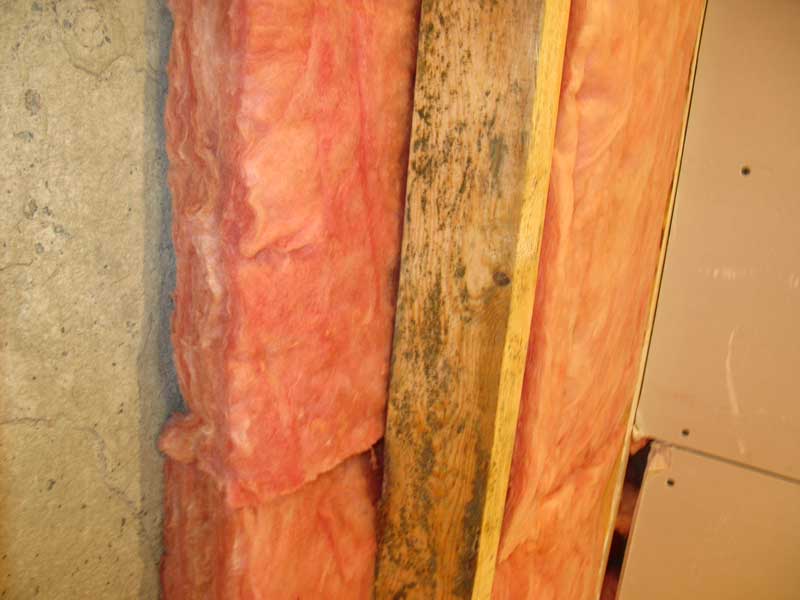
In the picture above, the plastic vapor barrier has been removed. The vapor barrier was particularly well done with all the seams being sealed with "acoustic sealant", a nasty permanently flexible goo that sticks to everything and ensures an airtight seal between the joins. The fundamental problem is this: The moisture content of wood is proportional to the surrounding air humidity, and the humidity level of any area with cement on one side and plastic on the other will approach 100% during the wet season. In the photo above, the cement wall felt very dry to the touch but the air humidity level was 98%. If you have moldy studs like this, Clorox CleanUp works well (sodium hypochlorite and detergent).
The relationship between wood moisture content and air humidity is as follows (taken from : Sampling and analysis of indoor microorganisms By Chin S. Yang, Patricia A. Heinsohn).
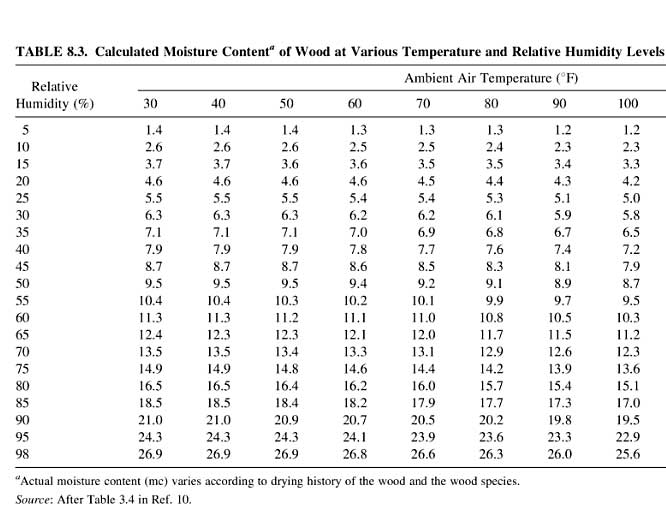
From the chart above, a cool basement at 10C/50F which reaches a humidity level a level of 90% in the wall cavity with vapor barrier would lead to a wood moisture content of 21%. To get the moisture content down to 15% or less (safe) you would have to keep the humidity below 75%. This is probably impossible. If you want to verify, get a remote temp/humidity sensor from Radio Shack and insert one in a basement wall behind the vapor barrier.
Here is the same stud with a moisture meter reading 18%. This is enough to support the growth of mold. Neighboring studs were mold free. I suspect that given a few more years, all the studs would have suffered the same fate. Even the single moldy stud and two rotten power nailed studs (pictured later in this page) were enough to give the entire basement a musty odor.
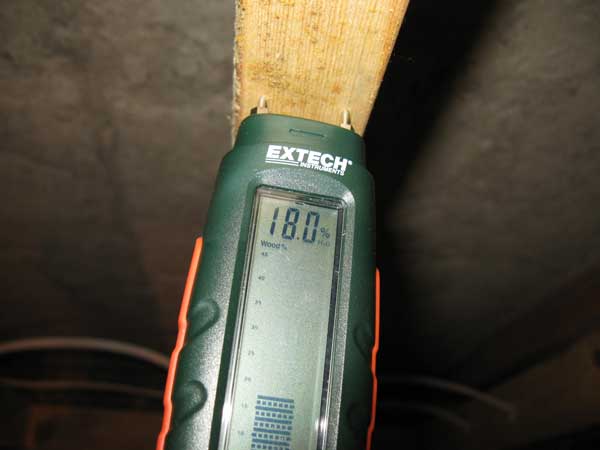
Things even get worse when the wood is in direct contact with cement and behind a vapor barrier. Moisture can wick directly from the porous cement to the wood, resulting in extremely high wood moisture content levels that go way beond what is possible even with an air humidity of 100%. The common practice of power nailing (Remington 22 caliber for example) studs to cement is not a good idea unless you want to use pressure treated stock rated from ground burial.
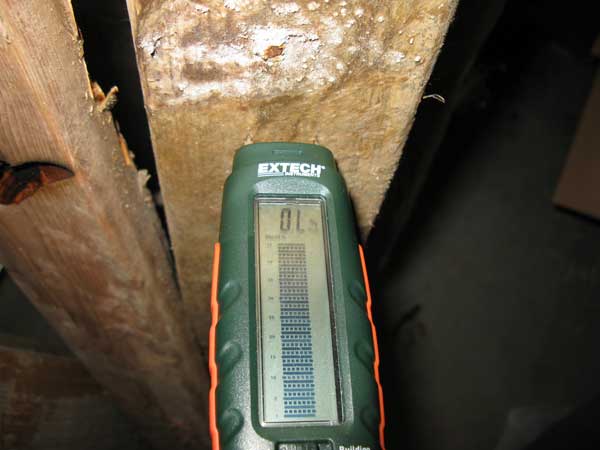
The stud above was power nailed directly to cement and so rotten after 2 years that it was crumbling. This pin based meter is reading "Over Load". A non destructive meter (no pin meter) gave similar bad news. Anything above 15% is enough to support the growth of mold.
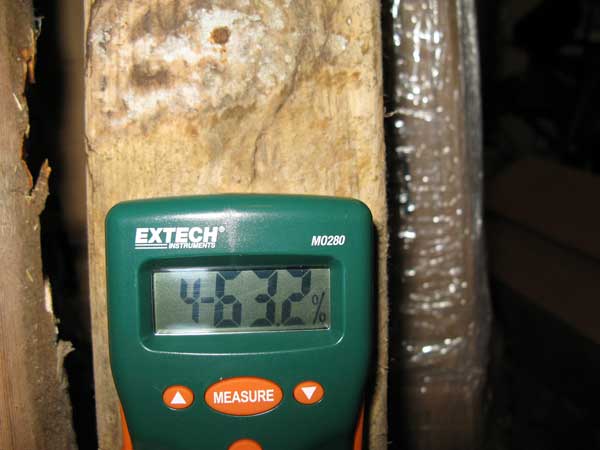
Solution:
The rate at which moisture enters needs from the ground, through the cement foundation must be reduced to a level at which drying to the interior (living space) keeps the wood stud's moisture content below 15%.
Step 1:
Seal the concrete with a silicate based sealer, such as the products from endur-o-seal. These are sprayed on to the cement with a garden sprayer, soak into the cement and fill the pores with a solution that gels and then hardens over a period of several days.
Step 2:
Ensure that eves troughs keep the water away, ideally several feet away from the foundation. In the close-up picture below, water was oozing through the metal concrete form ties. It doesn't show well in the picture below, but to the naked eye you could see the water drop at the end of the rusted tie, glistening. This wall is five years old and the eves trough was emptying only 8 inches from the foundation wall.

Step 3:
Attach non-porous insulation to the foundation walls to keep moist air from condensing and to slow down the rate at which moisture enters the wall cavity like this:
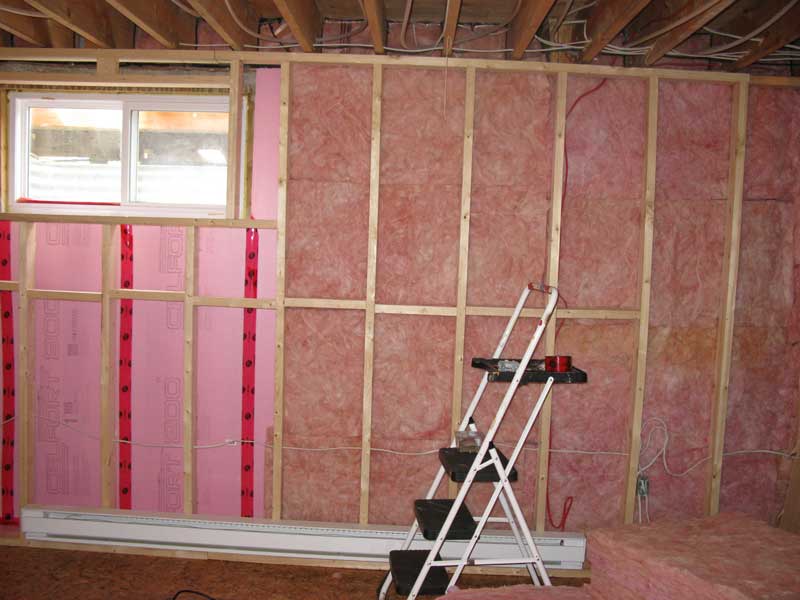
The pink foam is extruded polystyrene. The cheaper white "poly bead" insulation is far too porous to significantly slow down the moisture transfer. The red tape ("tuck tape") is sheathing tape, a permanent tape that sticks well to polystyrene and prevents any drafts entering between the sheets. The studs are in front of the insulation with a six inch gap behind for R20 fiberglass in addition to the R12 that can fit between the 2"x4" spruce studs shown. You likely don't need this much insulation - this house is heated with hot water from evacuated tube solar collectors and needs a high-performance thermal envelop.
Also make sure the studs have a week or more to dry out, and install a dehumidifier to speed up the process if necessary. This basement was dry to the touch but took about 10 days to achieve 50% air humidity and the dehumidifier was collecting 15 gallons per day.
Local code requires a vapor barrier between the studs and drywall and arguing with local inspectors is generally futile. One approach used by some builders is to crudely install six mil thick plastic barrier, making sure the electrical outlets are poorly sealed. This satisfies statute while allowing the moisture that will eventually build up inside the wall to escape to the heated interior.
I am not the only person that is thinking along these lines. Please see the following article: Basement Insulation Systems is extremely important to read if you are insulating your basement. It challenges the convention wisdom of using vapor barriers and is easy to read with excellent illustrations and photos.
--end--
